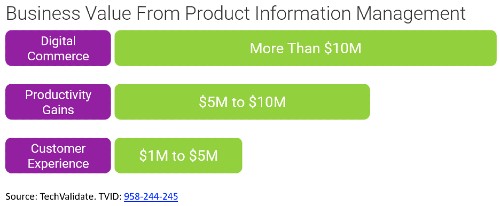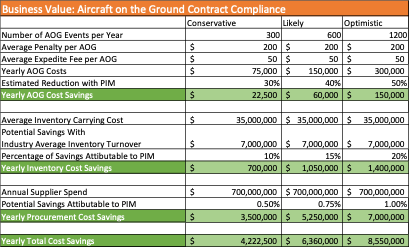Six Ways to Create a Product Information Management Business Case
What is product information management?

Product Information Management (PIM) is the process of managing product master data, associated information like descriptions and labels, and digital assets such as pictures and videos required for multichannel selling. PIM is relevant to both business-to-consumer (B2C) and business-to-business (B2B) companies, across industries that are marketing and selling products through a spectrum of channels including ecommerce websites, marketplaces (e.g., Amazon, Otto, Mercado Libre, Alibaba), social media platforms (e.g., Facebook, Instagram, Pinterest), print catalogs, and distribution partners.
How product information management can help your business
Product information management centralizes and streamlines the creation, maintenance, and distribution of product information. Spanning diverse groups of people and processes, PIM can help your business drive various workflow efficiencies, including:
- Product launches – Bringing a new product to market requires collaboration across multiple internal teams (e.g., development, procurement, product management) and external third parties (e.g., suppliers, translation agencies, logistics providers) as well as integration with multiple applications and business processes. With PIM, you can orchestrate data and task workflow between different entities in parallel. You can also dynamically re-route tasks and ownership based on different conditions rather than defaulting to a one-size-fits-all workflow approach.
- Campaign management – Launching and optimizing campaigns requires integrating campaign-specific workflows with end-to-end marketing and commerce processes. Using product information management, you can create and integrate workflows with marketing automation and ecommerce processes to quickly adapt product assortments to evolving customer needs across distribution channels.
- Regulatory compliance – Ensuring processes comply with industry regulations, laws, or guidelines requires rule- and exception-based workflows. As just one example, the workflow capabilities of PIM enable pharma companies to control which partners have access to what information by partner type (e.g., contract manufacturers, wholesale distributors, hospitals), supply chain segment, and product.
- Data syndication – Syndicating to data pools like Global Data Synchronization Network (GDSN) can help standardize formats and workflow, but you still need to manage syndication processes across multiple channels. With product information management, you can orchestrate sophisticated workflows to syndicate master data and digital assets across multiple channels with different format, file type, and language requirements.
Now that we have a shared understanding of what product information management is and some of the processes it supports, let’s look at two proven methods for building a business case to justify investing in PIM:
- Demonstrating digital transformation ROI with product information management
- Assessing product information management business value
With each of these methods, I’ll highlight three opportunities, which gets us to six ways to create a product information management business case.
How to create a product information management business case
Demonstrate digital transformation ROI with product information management
While digital transformation has been a priority for several years, over 80% of organizations across industries plan to accelerate their efforts, according to the World Economic Forum (WEF). This may not be surprising, as digital channels are becoming more important than ever to business growth, profitability, and resiliency. Unfortunately, the WEF also found that 70% of digital transformations have failed to achieve their objectives.
Fortunately, you can set your organization up for success. For example, WEF suggests looking for data and technology solutions that are business-oriented and designed for digital use cases. This creates an opportunity to demonstrate how product information management can help drive return on investment from strategic digital transformation initiatives. Here are three ways how to do this.
1. Personalizing the online customer experience – Most digital transformations include customer-centric initiatives , such as digital marketing, personalization, and improving the customer experience, among their primary goals. Product information management helps personalize descriptions, interactive media, and product recommendations based on customer profiles, channel activity, location, and other individual-specific attributes.
This one-minute video shows how product information management helps improve customer experience.
Puma’s use of this customer-centric approach helped increase conversions rates 10% to 20%. Contextual product experiences help customers feel more confident in online purchasing decisions.
Another Fashion and Apparel Company created a “store of the future,” which introduced innovations such as smart fitting room mirrors, “endless aisle” kiosks, digital magazine tables, product scanners, and shoppable walls. The company also built a digital showroom that allows wholesale customers to inspect products digitally instead of traveling to a physical facility to look at products and fabric swatches. By reducing the number of physical product samples needed, the digital showroom paid for the product information management investment in just one year. PIM is also providing high-quality product data that is improving the insights from machine learning models and advanced analytics used for customer centricity and personalization initiatives.

2. Bringing speed and agility to digital commerce – The speed of digital transformation in commerce during 2020 was unprecedented. There was the massive acceleration to online purchasing, changing consumer brand preferences, and direct to consumer initiatives. One way product information management helps improve ecommerce is through better assortment planning, which is critical to getting the right mix of products into different channels.
Using product information management, KLiNGEL can better determine which SKUs to sell through which channels, in which regions; create catalogs; and launch products seven times faster across 60 channels, in multiple languages. This efficiency has led to higher sales, fewer returns, and greater profitability.
Speed and agility are the name of the game in digital commerce. Out-of-stock items forced customers into trying new brands and alternatives in 2020, and now companies feel the need for speed. In fact, 93% of Informatica customers surveyed said faster time to market is a primary benefit of digital commerce. Using product information management, De Mandemakers Group reduces supplier and product onboarding 50%, enabling them to retain current customers and reach new ones, while simultaneously reducing costs.
3. Improving supply chain visibility and proactively mitigating risk – Supply chain transparency and balancing costs, risks and resiliency are C-suite agenda topics now. Product information management enables more accurate risk assessment and remediation planning by improving visibility into:
- What materials are required to manufacture products
- Which suppliers provide those materials in different regions
- What volume is being purchased through those suppliers across divisions and plants
During the early part of COVID, Unilever pledged €500m (£457m) of cash flow relief to support its extended supply chain, including early payments for its most vulnerable small- and medium-sized suppliers, and extending credit to selected small-scale retail customers whose businesses rely on Unilever. During Informatica’s Digital Commerce and Supply Chain Summit, their chief technology officer described how better visibility helped them mitigate supply disruption during the COVID pandemic.
Product information management helps automate data collection, cleansing, classification, harmonization, and distribution to multiple downstream systems, such as financial, inventory management, warehousing, and marketing systems. Consistent information across the enterprise helps increase the speed and accuracy of activities like demand forecasting, production planning, and financial reporting and analysis in response to highly variable supply and demand signals.
And while companies pivoted quickly to enable front-end, ecommerce activity in 2020, the last-mile delivery logistics component proved to be a challenge for many organizations. According to McKinsey poor order fill rates could cut margins by 1%, due to allowances, discounts, and loss of business. Product information management can help improve order fulfillment rates. It can also increase pick-and-pack process efficiency by providing visibility into the quantity and location of products in the warehouse as well as packaging information such as temperature and fragile/breakage requirements. Curbside pickup is a common logistics use case where PIM offers significant benefit.
Assessing product information management business value
Sometimes connecting product information management to strategic digital transformation initiatives is enough to justify the investment. And sometimes you’re going to need to build a more detailed business value assessment. If you’re building a formal business case for PIM, keep the following in mind.
When projects need to be formally justified with a business case, finance teams will typically be asked to evaluate your business case against other competing requests for capital, so get as specific as you can, document your assumptions, and provide a range of scenario outcomes such as conservative, likely, and optimistic. Since finance will be evaluating your PIM business case, it’s time to think like a CFO, and they generally bucket value opportunities in three categories revenue, cost, and risk management.
1. Revenue management – Product information management can help acquire net new customers, grow wallet share of existing customers, and/or retain profitable customers. The business case details will be specific to your organization, but here’s one example of how to approach it.
A fashion and apparel company realized they were losing sales due to products not being available to fill a particular price point in their lineup for a category. This was caused by product information being coded incorrectly. For example, a regional category manager might have selected a sample trail running shoe to fill their $50–$75 price point as part of their seasonal assortment planning, only to find out too late that the sample was never authorized for production in their geography. After some analysis of the problem, they estimated lost sales at around $100 million annually.
Now they didn’t just say, oh we can increase revenue by $100 million dollars annually. They built a simple spreadsheet model with conservative, likely, and optimistic estimates of both the amount of lost revenue and reduction in lost sales. They also looked up gross profit margin in the company’s annual financial report, so they could calculate the profit potential. Then they were able to show their investment in product information management would pay for itself in the first year just using the conservative scenario.

2. Cost management – Product information management can help reduce cost in several areas, such as customer acquisition, service and support, procurement and inventory, and shipping. Value opportunities for cost management can also be expressed in productivity and/or efficiency gains (e.g., reducing the cost associated with data management and analytics).
It’s a common misconception that product information management is only for companies in the retail and wholesale value chains. But PIM can deliver value across a broad spectrum of industries. For example, an aviation maintenance services company was struggling to manage cost associated with Aircraft on the Ground (AOG) service-level agreements (SLAs). In their contracts, there is language specifying service-level timelines and penalties based on various levels of time an aircraft remains grounded beyond the SLA.
Their initial reaction was to purchase and stock more inventory and expedite parts to locations when required. This wasn’t an optimal solution, as it increased inventory-carrying costs and working capital requirements, which in turn reduced cash flow and liquidity. They also struggled to identify parts that could be substituted for each other due to poor quality information about parts specifications. And they lacked visibility into how much they were spending with various suppliers, and which suppliers had parts with high frequency of failures/returns. They used multiple AOG related costs to build their business value assessment.

3. Risk management – Product information management can help reduce a wide range of risks like customer churn, supply chain disruption, and regulatory compliance. Value opportunities for cost management can also be expressed in productivity and/or efficiency gains.
A European alcohol beverage producer was having problems complying with tax regulations. Alcohol is subject to excise duties in all EU member states and must be paid in the Member State of consumption. The tax is based on alcohol content and volume, and the rate varies across countries making cross-border shipment compliance challenging.
They estimated annual penalty payments at €12.8 million per year. Compliance issues also landed them on the watch list of agencies that could hamper their ability to distribute their products throughout the European Union. Poor product information in documentation and movement and control systems was the problem, making their business value assessment simple.

Get started: Create your product information management business case
I’ve shared what product information management is and some of the processes it supports, as well as two proven methods for building a business case to justify investing in PIM. I also gave three examples of connecting PIM to digital transformation success and three examples for creating PIM business value assessments. Now that you know six ways to create a product information management business case, it’s time for you to create your own.
Remember this blog post was by no means an exhaustive list. Your company might have a corporate strategy of growth through acquisition, which gives you an opportunity to show how product information management helps your company do more deals and deliver greater ROI per deal. Look for the strategic initiatives, think like a CFO, and be creative. I’d love to hear how you created your product information management business case.








